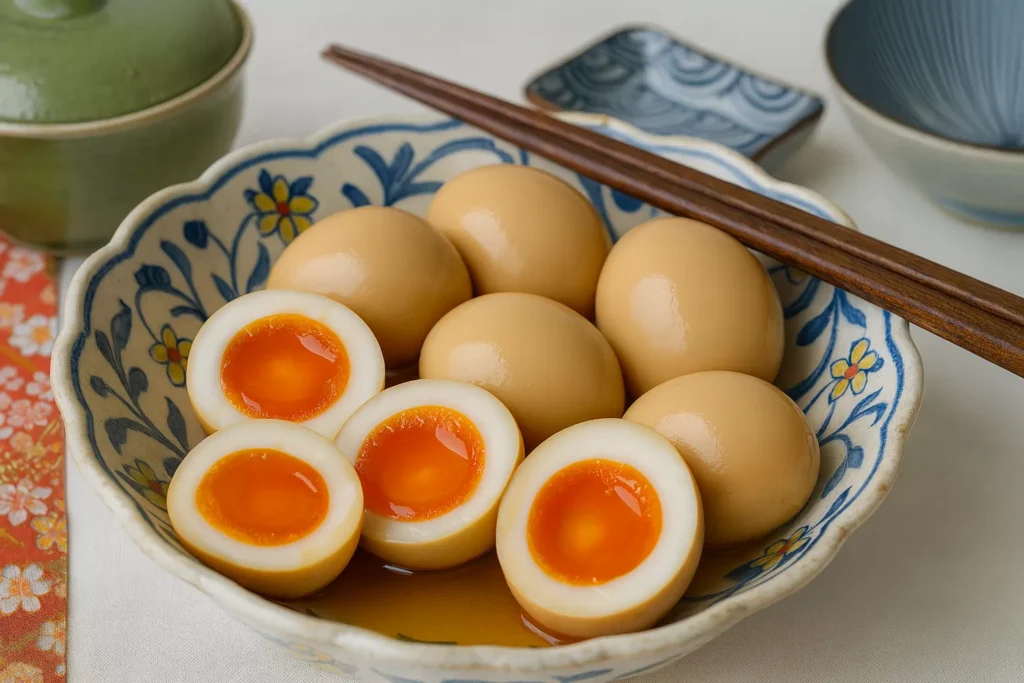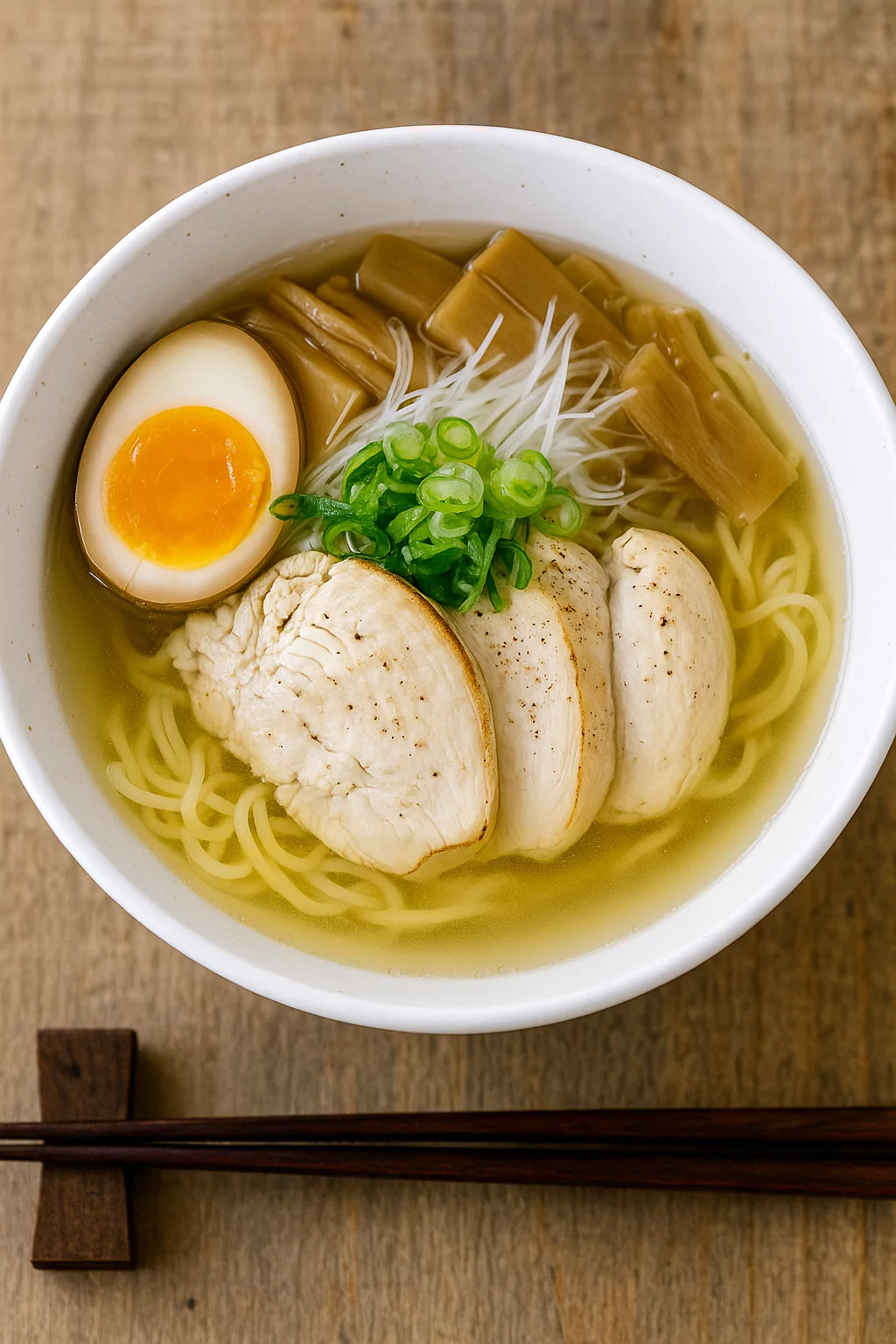Have you ever wondered why the soft, golden-centered eggs in a bowl of ramen taste so rich and flavorful compared to regular boiled eggs? Many people think the secret is in the soup, but the real magic comes from a special kind of marinated egg known as Ramen Eggs, or Ajitsuke Tamago 味付け玉子. These eggs look simple, yet they carry deep flavor, a delicate texture, and a unique taste that instantly transforms a dish. What makes them so different, and how can such a basic ingredient become the highlight of a meal?
This recipe will guide you step by step, showing how to create Ramen Eggs at home with ease. Whether you are new to Japanese cooking or already enjoy making ramen from scratch, these eggs are simple to prepare, easy to customize, and perfect for meal prep.
Overview
Ramen Eggs, also known as Ajitsuke Tamago or 味付け玉子, are soft-boiled eggs soaked in a savory marinade. The center stays creamy while the whites absorb the sweet and salty mixture. What makes this recipe special is the balance of flavors and the slow marinating process that infuses each egg with depth.
This recipe requires only a few ingredients and very little cooking skill. The difficulty level is low, and most of the time is spent waiting while the eggs soak in the marinade. In just a few hours, you can achieve restaurant-style results.

What Are Ramen Eggs (Ajitsuke Tamago 味付け玉子)?
Ramen Eggs are marinated soft-boiled eggs commonly served on top of Japanese ramen. The outer layer becomes tinted from the marinade, while the inside stays tender and slightly custardy. These eggs are popular for their umami taste, versatility, and attractive appearance. They can be used in ramen bowls, rice dishes, salads, or enjoyed as a snack.
The marinade typically includes soy sauce, sugar, mirin, and sometimes stock for extra richness. Because the eggs soak for several hours, they develop layers of flavor that set them apart from plain boiled eggs.
Essential Ingredients
Key Ingredients (材料)
Ramen Eggs 味付け玉子These simple ingredients create the rich, savory, and tender texture of homemade Ramen Eggs, known as Ajitsuke Tamago 味付け玉子. Each card explains the purpose of the ingredient and offers easy substitutions when available.
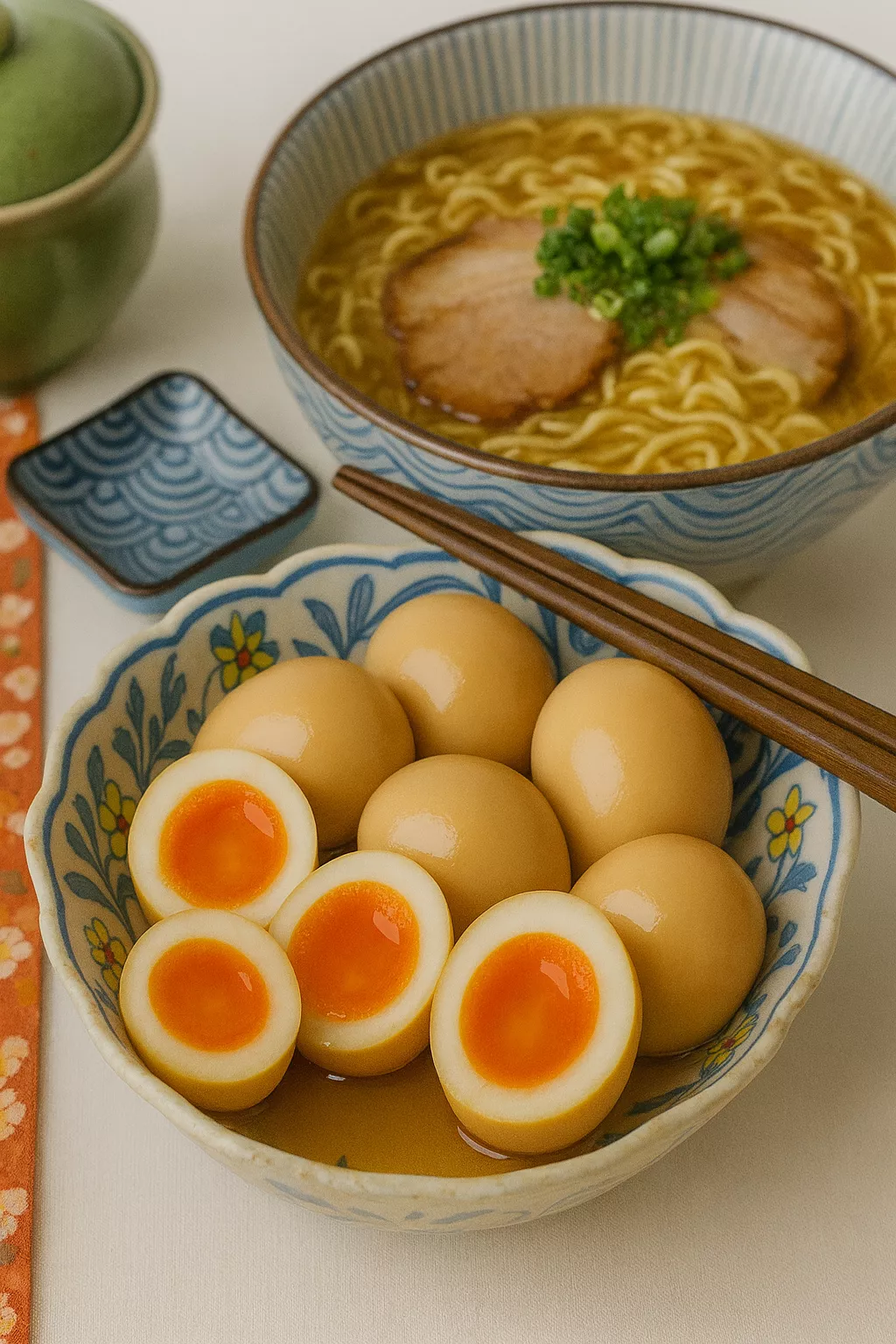
Step-by-Step Instructions
Step 1: Make the Marinade
Combine the following in a small saucepan:
- 3 tablespoons soy sauce
- 3 tablespoons water
- 2 tablespoons sugar
- 2 tablespoons mirin
- 1/2 teaspoon chicken stock powder
Place the saucepan over medium heat and bring the mixture to a gentle boil. Once it reaches a boil and the sugar has dissolved fully, turn off the heat. Set the marinade aside and allow it to cool completely. A hot marinade will overcook the eggs, so cooling is essential.

Step 2: Prepare the Boiling Water
Fill a pot with enough water to fully cover the eggs.
Add 1 tablespoon of vinegar (this helps with easy peeling, though it is not part of the main recipe).
Bring the water to a full boil over medium-high heat.

Step 3: Add the Eggs
When the water is boiling, gently lower the eggs into the pot using a ladle or spoon. Adding them gently prevents cracking.
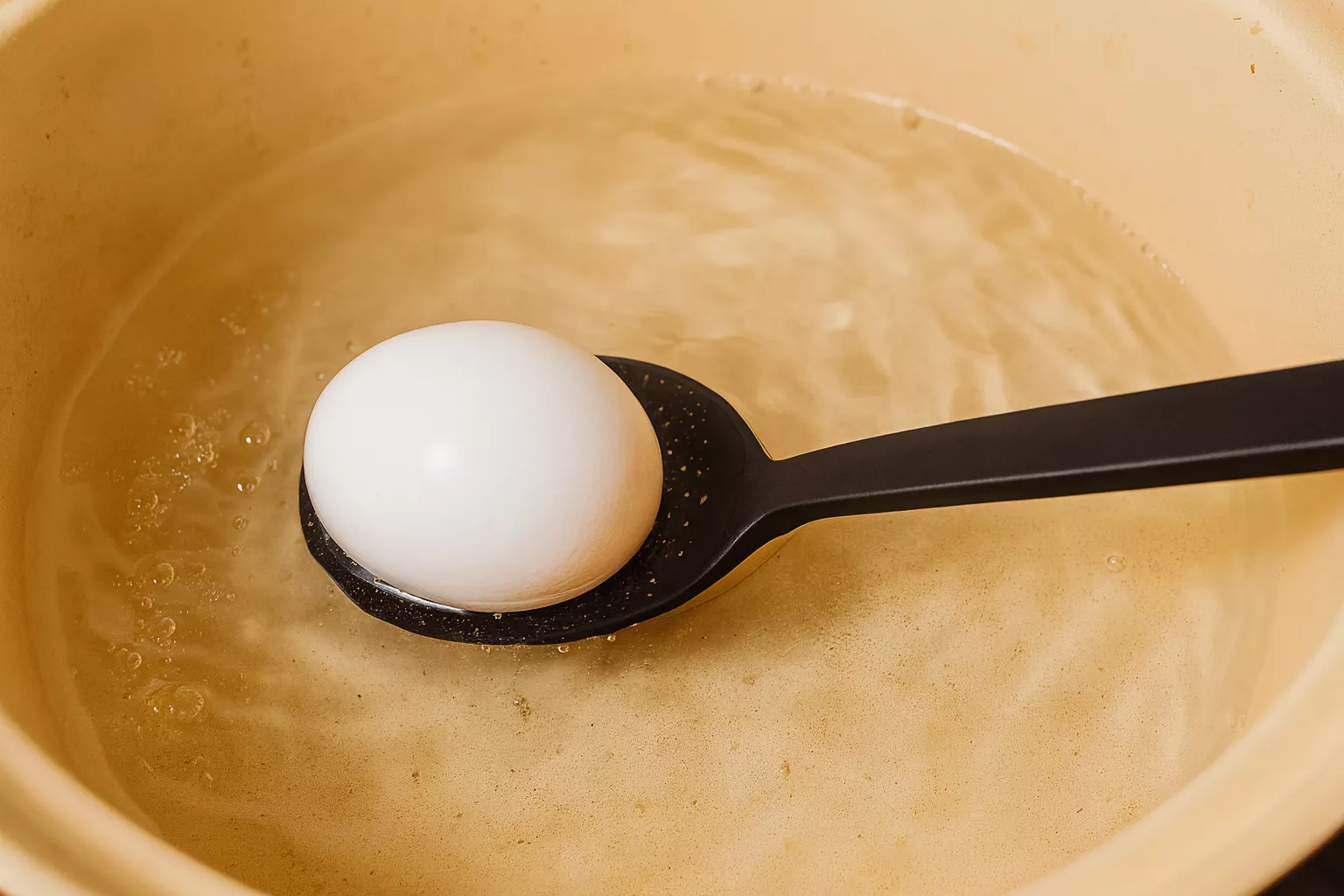
Step 4: Control the Movement
For the first 1–2 minutes, lightly roll the eggs around the pot. This helps center the egg yolks, giving you a perfect interior when sliced.
Step 5: Cook to Your Preferred Softness
Continue boiling until the eggs reach your desired doneness.
For classic Ramen Eggs with a soft center, boil for about 6–7 minutes.
For a firmer texture, extend the cooking time by 1–2 minutes.
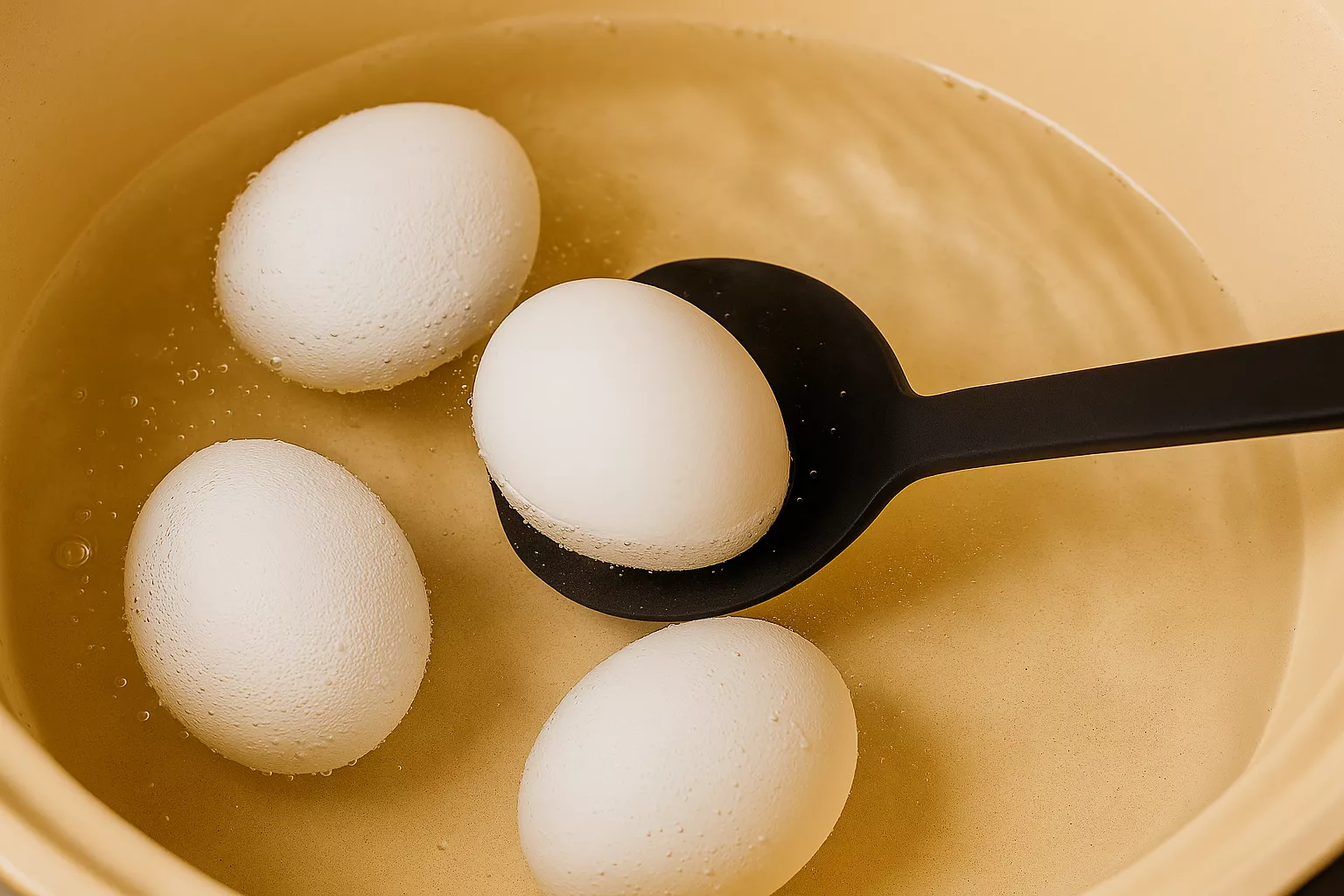
Step 6: Cool the Eggs
Once the cooking time is finished, immediately transfer the eggs to a bowl of cold water. This stops the cooking process and helps preserve the soft yolk.

Step 7: Peel the Eggs
When the eggs are cool, gently peel off the shells. Take your time so the whites stay smooth and intact.
Step 8: Marinate
Place the peeled eggs into a small food-safe container or zip-lock bag.
Pour in the cooled soy sauce marinade until the eggs are fully covered.
Seal the bag or close the container.
Let the eggs soak for 2–3 hours for a mild flavor or 5–6 hours for a richer, deeper taste. The longer the eggs sit, the more flavor they absorb.

Secrets to Success and Expert Tips
These simple but important tips will help you make soft-boiled, flavorful, and perfectly marinated Ramen Eggs (Ajitsuke Tamago 味付け玉子) every time:
-
♥
Roll the eggs gently during the first minute of boiling
This helps center the yolk so you get a perfectly shaped soft center when sliced. A centered yolk also gives a neat, professional look. -
♥
Shock the eggs in cold water immediately
Cooling them fast stops the cooking process and prevents the yolk from becoming firm. It also makes peeling the shells easier and cleaner. -
♥
Always cool the marinade before adding the eggs
Warm marinade will continue cooking the eggs and ruin the soft, creamy center. Make sure the mixture is completely cooled before marinating. -
♥
Use a small container or a zip bag
Keeping the eggs close together ensures the marinade covers the entire surface evenly. Rotate the eggs occasionally for perfect color. -
♥
Slice with a string for a clean cut
Soft-boiled yolks tend to stick to knives. Using a thin string or unflavored dental floss creates a smooth, restaurant-style cut every time.
Assembly
Ramen Eggs can be served in many ways, but the most popular method is topping a bowl of ramen. When assembling a dish, place the eggs on top or on the side so they stay visible. The golden center adds color and appeal, especially when paired with broth and noodles.
You can also place Ramen Eggs on warm rice, sprinkle green onions and roasted sesame on top, and drizzle a small amount of leftover marinade for added flavor. This simple preparation makes a satisfying meal.
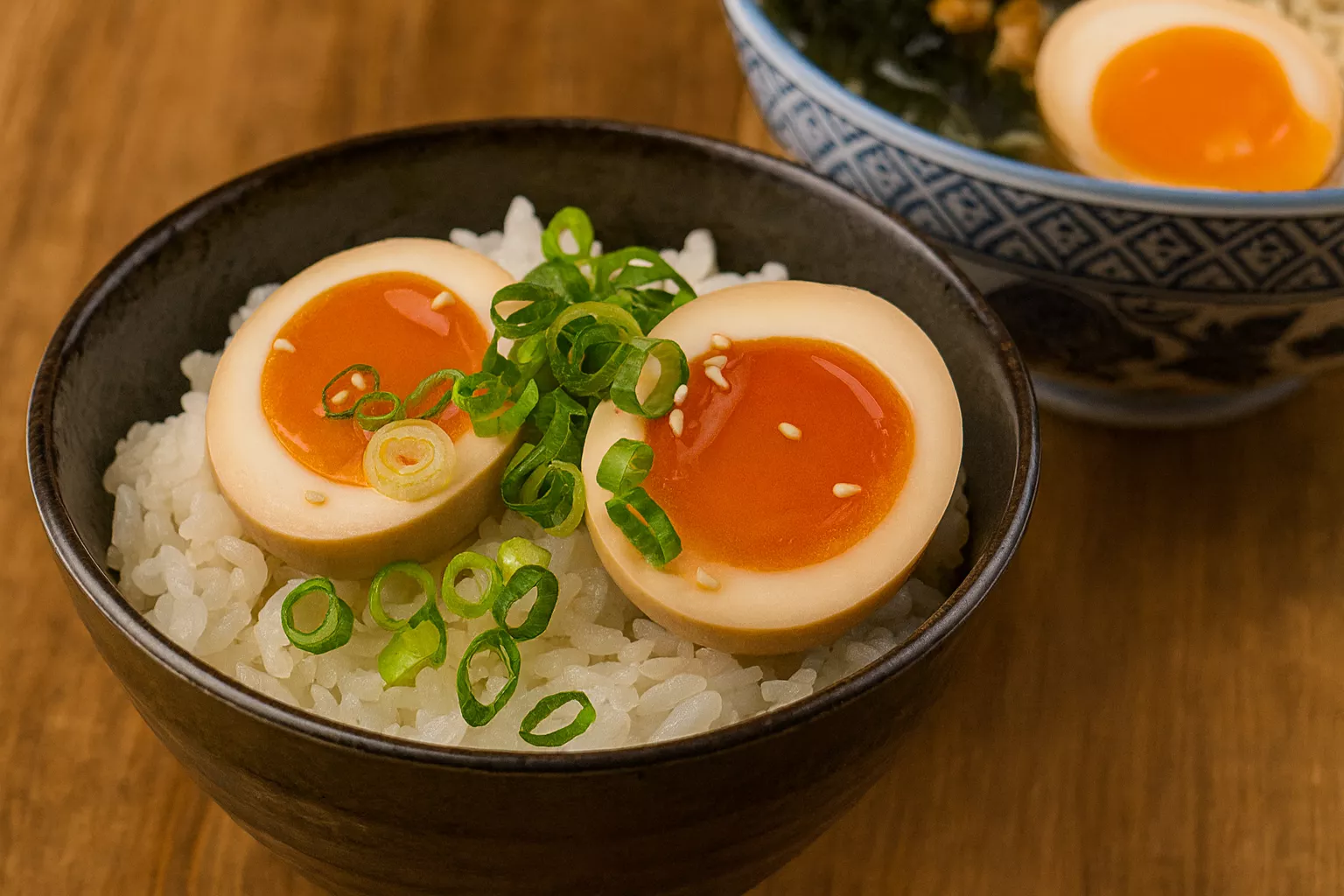
Presentation Tips
- Cut the eggs neatly with string for a professional look.
- Arrange them with the cut side facing up.
- Add roasted sesame and chopped green onions for freshness and texture.
- Avoid soaking for longer than 24 hours, as the eggs may become too salty and change texture.
Hana’s Recipe Tips
- Use medium heat when boiling the marinade to avoid burning the sugar.
- For best results, marinate overnight if you prefer a deeper flavor, but check the salt level since soy sauce intensity varies.
- If you plan to serve the eggs with ramen, prepare them the day before to save time and allow full flavor development.
- When storing in the fridge, keep the eggs in a covered container to maintain moisture and freshness.
- To make the recipe lighter, use low-sodium soy sauce but maintain the sweetness level to keep the flavor balanced.
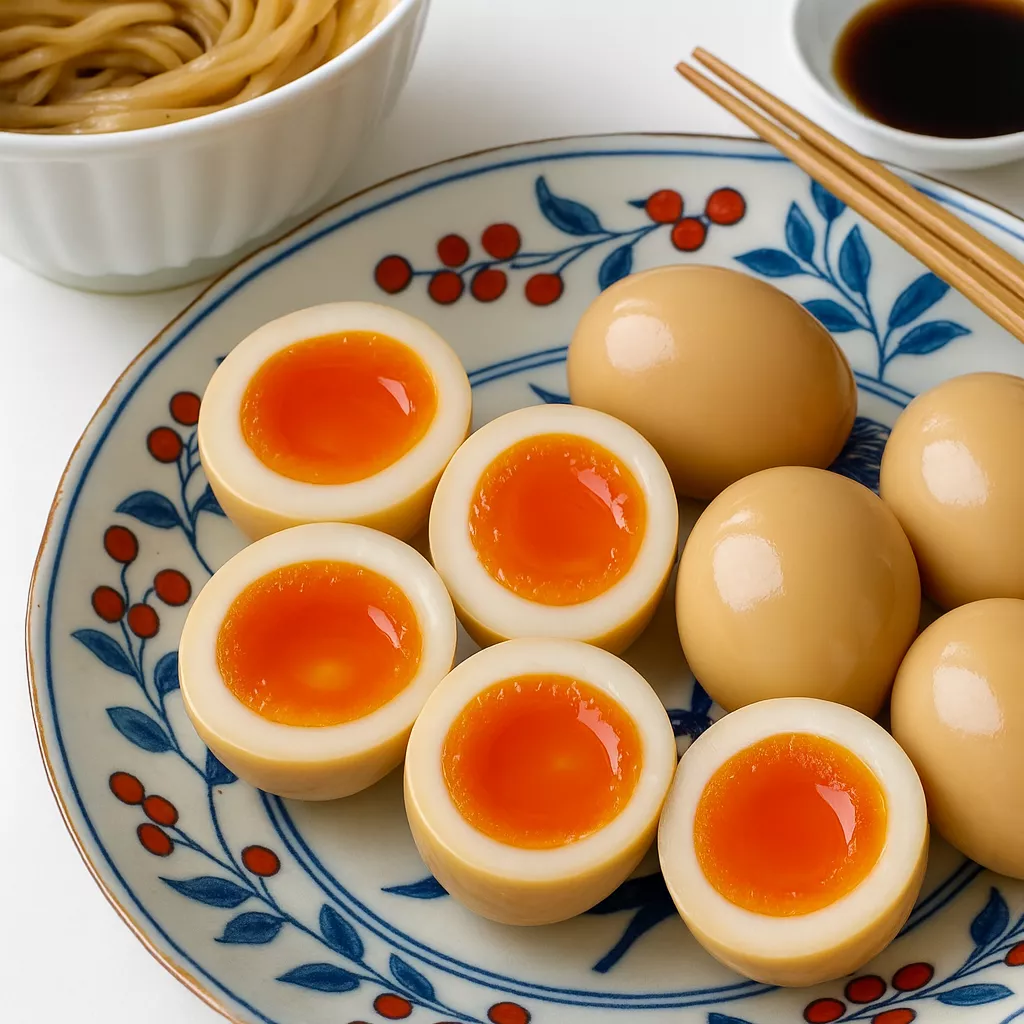
Storage and Make-Ahead Tips
Ramen Eggs store well in the refrigerator for up to 3 days. Keep them submerged in the marinade inside a sealed container. This maintains their texture and prevents drying.
If you want to make them ahead for meal prep, prepare a larger batch and keep them whole until serving. Avoid freezing, as freezing changes the texture of the egg whites and can cause them to become rubbery.
When reheating, avoid heating the eggs directly. Instead, allow them to sit at room temperature for 10–15 minutes before serving. They should never be reheated in the microwave.
Recipe Variations
Ramen Eggs (Ajitsuke Tamago 味付け玉子) are very customizable. You can change the marinade, adjust the sweetness, or add subtle flavors to match your ramen style or personal taste. Here are some delicious ways to make your ramen eggs unique:
Try New Flavors
Enhance the marinade with extra flavor boosters:
- Crushed garlic for a deeper savory taste
- A splash of rice vinegar for brightness
- A small piece of kombu for gentle umami
Adjust the Marinade
Customize the taste by changing the balance of ingredients:
- More sugar for a sweeter, mellow flavor
- Extra soy sauce for a darker, stronger taste
- Add chili oil for a spicy finish
Choose Your Egg Texture
Adjust the boiling time to change the final texture:
- 6 minutes for very soft, runny centers
- 7 minutes for classic ramen-style custard yolks
- 8–9 minutes for firmer centers
Try New Serving Styles
Serve your ramen eggs in creative ways beyond traditional ramen bowls:
- On rice bowls with green onions and sesame
- As a flavorful protein for salads
- Sliced on top of cold noodles during summer
Related Recipes You Will Love
If you enjoy making Ramen Eggs and want to explore more Japanese noodle dishes, here are two delicious recipes that pair perfectly with Ajitsuke Tamago. For a light and soothing bowl, try the Shio Ramen 塩ラーメン, a simple salt-based ramen with a clean, savory broth that highlights the flavor of your homemade eggs.
If you prefer a richer dipping-style experience, make Tsukemen つけ麺 (Dipping Ramen Noodles), where cold noodles are dipped into a warm, concentrated broth. These marinated eggs make an excellent topping for the noodles or served on the side.
Conclusion
Ramen Eggs, or Ajitsuke Tamago 味付け玉子, may look like a simple side dish, but they offer remarkable flavor and versatility. With only a few ingredients and an easy preparation method, you can make a batch that tastes like it came from a specialty ramen shop. These eggs enhance any meal, from ramen bowls to simple rice dishes, and they are perfect for making ahead.
Trying different variations and adjusting the marinade allows you to create a version that suits your taste. The process is easy, but the result is rich, satisfying, and full of depth.
FAQs
How long should I marinate Ramen Eggs?
You can marinate them for 2–3 hours for a lighter flavor or up to 6 hours for a deeper taste. Beyond 24 hours, the eggs may become too salty.
Can I use low-sodium soy sauce?
Yes. Low-sodium soy sauce works well and helps control the salt level while keeping the flavor balanced.
What makes Ramen Eggs different from regular boiled eggs?
Ramen Eggs are marinated after boiling, giving them a savory taste and a soft, custard-like center.
Can I serve Ramen Eggs without ramen?
Yes. They pair well with rice, vegetables, salads, or even on their own as a snack.
Are Ramen Eggs healthy?
They are high in protein and contain nutrients from the marinade ingredients. They fit well into many balanced meals.
How do I slice Ramen Eggs neatly?
Use a thin string or floss to cut through the egg cleanly without damaging the yolk.
Can I prepare the marinade ahead of time?
Yes. The marinade can be made and refrigerated for up to three days before using.
Ramen Eggs (Ajitsuke Tamago) 味付け玉子
Course: MainCuisine: JapaneseDifficulty: Easy4
servings5
minutes7
minutes90
kcalSoft-boiled eggs marinated in a savory soy-based sauce. These Japanese ramen eggs have a creamy center and deep flavor, perfect for ramen bowls, rice dishes, or meal prep.
Ingredients
- Marinade
3 tablespoons soy sauce
3 tablespoons water
2 tablespoons sugar
2 tablespoons mirin
1/2 teaspoon chicken stock powder
- Eggs
4 eggs
- Optional for serving
Chopped small green onions
Roasted sesame seeds
Directions
- Make the marinade
Combine soy sauce, water, sugar, mirin, and chicken stock powder in a small saucepan. Heat until it begins to boil, then turn off the heat and let it cool completely. - Prepare the boiling water
Fill a pot with enough water to cover the eggs and add 1 tablespoon of vinegar (optional). Bring the water to a full boil. - Add the eggs
Gently lower the eggs into the pot with a ladle. Roll them lightly for the first 1–2 minutes to center the yolks. - Cook the eggs
Boil for 6–7 minutes for soft-boiled centers, or slightly longer if you prefer a firmer yolk. - Cool the eggs
Transfer the eggs to a bowl of cold water to stop the cooking. When cool, peel them carefully. - Marinate the eggs
Place the peeled eggs into a container or zip bag. Pour in the cooled marinade, making sure the eggs are fully covered. Let them soak for 2–3 hours for mild flavor or 5–6 hours for a deeper taste. - Serve
Slice using a thin string for clean cuts. Serve with ramen, over rice, or topped with green onions and roasted sesame seeds.
Notes
- ✪ Always cool the marinade before adding the eggs to prevent overcooking.
✪ Rotate the eggs while marinating for even coloring.
✪ Store in the refrigerator for up to 3 days in the marinade.
✪ For very soft yolks, reduce boiling time to 6 minutes; for firmer yolks, increase to 8 minutes.
Did you make this recipe?
Tag @jp.dishes on Instagram so we can see your delicious creation!
